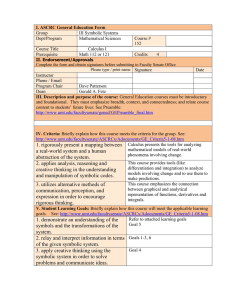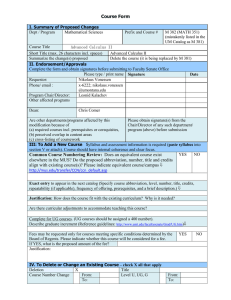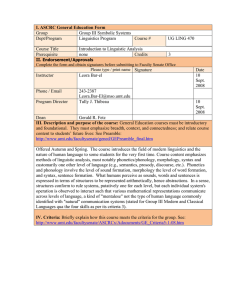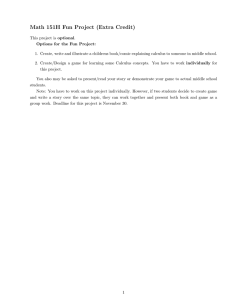I. ASCRC General Education Form Group III Symbolic Systems Dept/Program
advertisement
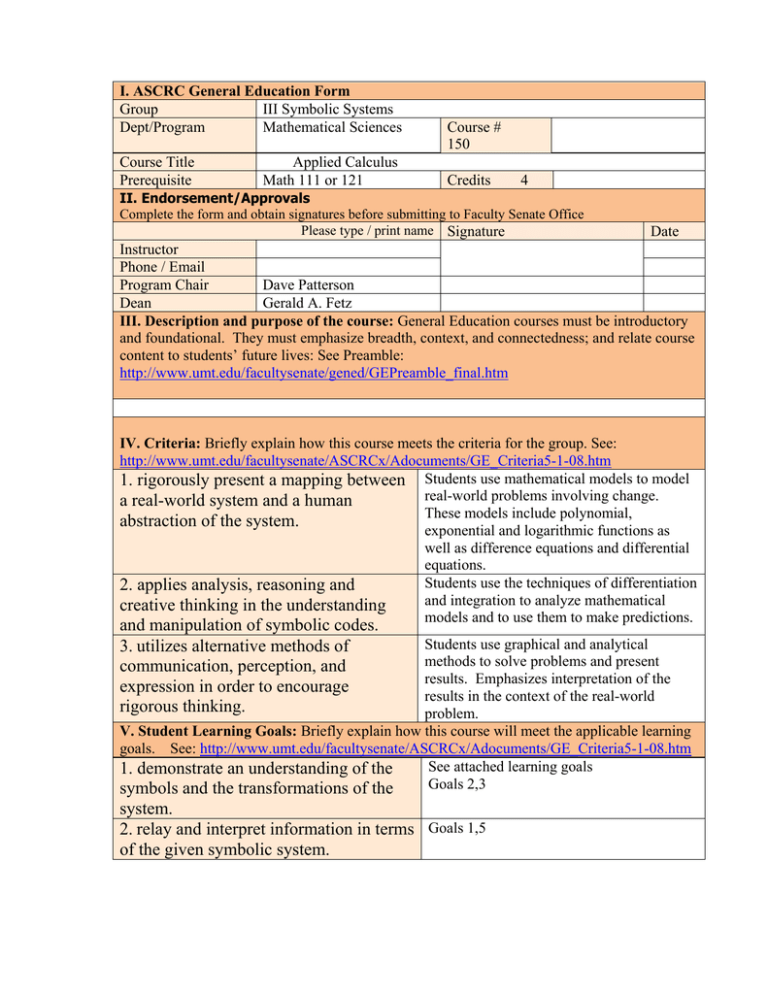
I. ASCRC General Education Form Group III Symbolic Systems Dept/Program Mathematical Sciences Course Title Prerequisite Applied Calculus Math 111 or 121 Course # 150 Credits 4 II. Endorsement/Approvals Complete the form and obtain signatures before submitting to Faculty Senate Office Please type / print name Signature Date Instructor Phone / Email Program Chair Dave Patterson Dean Gerald A. Fetz III. Description and purpose of the course: General Education courses must be introductory and foundational. They must emphasize breadth, context, and connectedness; and relate course content to students’ future lives: See Preamble: http://www.umt.edu/facultysenate/gened/GEPreamble_final.htm IV. Criteria: Briefly explain how this course meets the criteria for the group. See: http://www.umt.edu/facultysenate/ASCRCx/Adocuments/GE_Criteria5-1-08.htm 1. rigorously present a mapping between Students use mathematical models to model real-world problems involving change. a real-world system and a human These models include polynomial, abstraction of the system. exponential and logarithmic functions as well as difference equations and differential equations. Students use the techniques of differentiation 2. applies analysis, reasoning and and integration to analyze mathematical creative thinking in the understanding models and to use them to make predictions. and manipulation of symbolic codes. 3. utilizes alternative methods of communication, perception, and expression in order to encourage rigorous thinking. Students use graphical and analytical methods to solve problems and present results. Emphasizes interpretation of the results in the context of the real-world problem. V. Student Learning Goals: Briefly explain how this course will meet the applicable learning goals. See: http://www.umt.edu/facultysenate/ASCRCx/Adocuments/GE_Criteria5-1-08.htm See attached learning goals 1. demonstrate an understanding of the Goals 2,3 symbols and the transformations of the system. 2. relay and interpret information in terms Goals 1,5 of the given symbolic system. 3. apply creative thinking using the symbolic system in order to solve problems and communicate ideas. Goal 4 VII. Syllabus: Paste syllabus below or attach and send digital copy with form. ⇓ The syllabus should clearly describe how the above criteria are satisfied. For assistance on syllabus preparation see: http://teaching.berkeley.edu/bgd/syllabus.html Attached *Please note: As an instructor of a general education course, you will be expected to provide sample assessment items and corresponding responses to the Assessment Advisory Committee. Course: MATH 150 Title: Applied Calculus Date revised: September 10, 2008 I. II. Purpose of the Course: To teach students in areas outside of mathematics how to use calculus as a tool to measure change and solve problems. This is a service course where content and methods are somewhat driven by the clientele. Course Description (from http://www.umt.edu/catalog/mathsci.htm): U 150 Applied Calculus 4 cr. Offered autumn and spring. Prereq., appropriate placement score or one of MATH 111, 112, or 121. Introductory course surveying the principal ideas of differential and integral calculus with emphasis on applications and computer software. Mathematical modeling in discrete and continuous settings. Intended primarily for students who do not plan to take higher calculus. III. Credit Hours: 4. IV. Frequency of Offering: Every semester ( 1 lecture, about 8 discusseion sections). V. Audience: Primarily students from wildlife biology, biology, microbiology, pharmacy, forestry, and other life sciences. Very few business students take this course. VI. Learning Goals (What do we want the students to learn?): 1. To learn how to apply calculus as a tool for solving applied problems, such as describing change using calculus techniques. 2. To learn basic techniques of differentiation and meaning of derivative. 3. To learn basic techniques of integration and meaning of indefinite and definite integral. 4. To gain exposure to elementary modeling in terms of differential and/or difference equations. 5. To become familiar with some mathematical software as a tool for applying calculus. VII. Typical Methods of Course Assessment: EX (W, IC, TH), HW. VIII. Course Format: 3 weekly lectures and 1 weekly practice session (including lab). IX. Use of Technology (if any): Scientific Work Place

